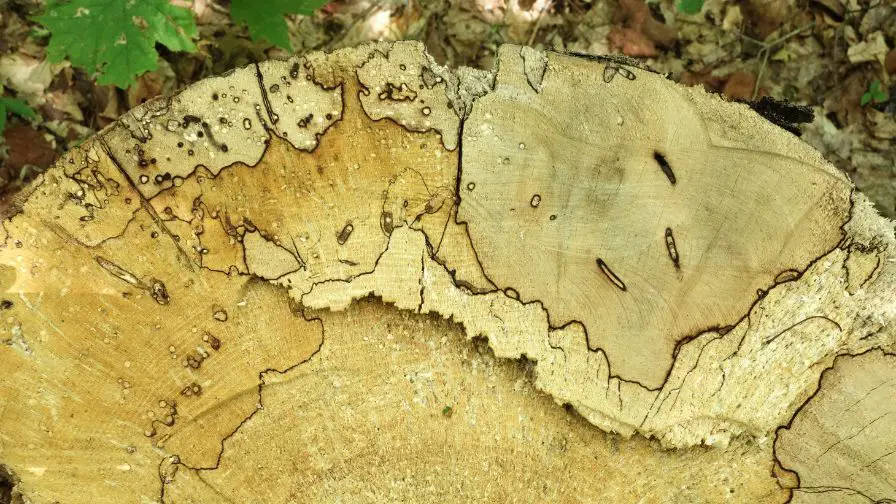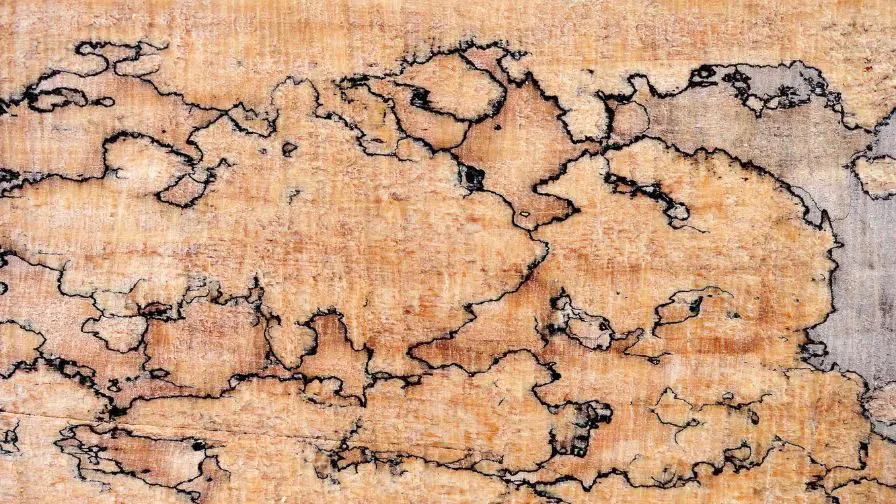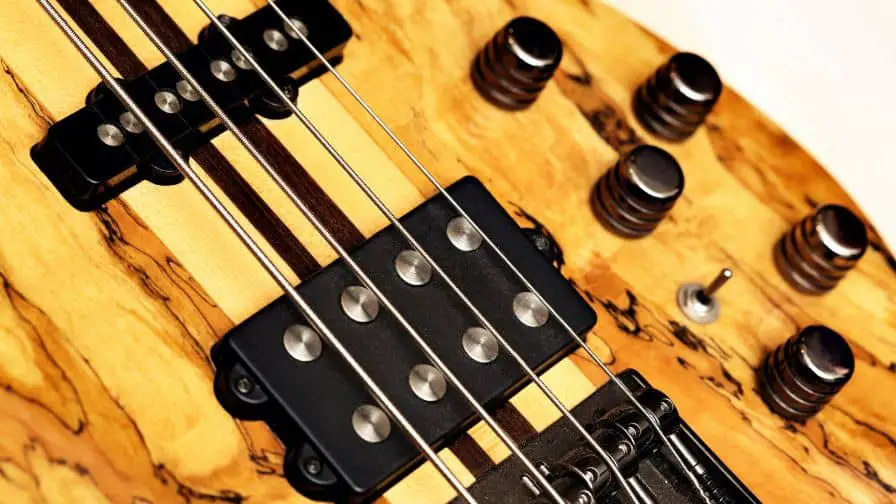
If you’re looking for a beautiful and unique wood to use in your next project, look no further than spalted maple!
This type of maple is characterized by its dark streaks and swirls, which make it a favorite among woodworkers.
In this guide, we will discuss the different types of spalted maple, as well as how to work with it. We’ll also provide some tips on how to care for your spalted maple boards. So whether you’re a beginner or an experienced woodworker, this guide has something for you!
What Is Spalted Maple And Where Does It Come From?
Spalted maple is a type of wood that has been affected by fungus. The spores of the fungus enter the wood through cracks or wounds, and as the fungi grow, they produce patterns called “spalting.” These patterns can be very beautiful, and spalted maple is often used in making furniture and other decorative items.
Spalted maple is most commonly found temperate regions in the Northern Hemisphere, although it can be found in other parts of the world as well.
What Causes Spalted Maple?
Now that we know what spalted maple is, let’s take a look at what causes it.
Spalting is caused by certain white-rot decay fungi growing in the wood. These fungi break down the cellulose and lignin in wood, which gives spalted maple its distinctive coloration and patterns.
The fungi need oxygen to survive, so they only grow in wood that has been cut or damaged. This is why you’ll often see spalted maple in antique furniture or in logs that have been sitting on the ground for a long time.
Subscribe to Blacktail Studio on YouTube
The Different Types Of Spalted Maple
There are four different types of spalted maple: Ambrosia, Black, Tiger, and Fiddleback.
Ambrosia Maple is the most common type of spalted maple. The Ambrosia fungus creates a unique pattern on the wood that resembles burl wood.
Black Spalted Maple is less common than Ambrosia Maple. The black color is a result of the tannin in the wood. Black Spalted Maple has a bolder look than Ambrosia Maple.
Tiger Spalted Maple is the rarest type of spalted maple. The tiger stripes are created by the bacteria that cause the wood to rot. Tiger Spalted Maple is the most expensive type of spalted maple.
Fiddleback Spalted Maple is the second rarest type of spalted maple. The fiddleback pattern is created by the fungi that cause the wood to rot. Fiddleback Spalted Maple is less expensive than Tiger Spalted Maple.
Spalted maple is a unique and beautiful wood. It is perfect for furniture, cabinets, and other woodworking projects. if you are looking for a unique wood, then spalted maple is a perfect choice.
How To Work With Spalted Maple
Spalted maple is one of the most unique and beautiful woods available for woodworking. Its distinctive patterns are created by fungi that invade the wood while it is still alive. This invasion causes the wood to change color and create interesting patterns.
Spalted maple is not only beautiful, but it is also strong and durable. It is an excellent choice for furniture, cabinetry, and other woodworking projects.
When working with spalted maple, it is important to take into account the unique patterns of the wood. These patterns can make it difficult to work with traditional woodworking techniques. In addition, the fungi that cause the spalting can continue to grow even after the wood is harvested. This can cause the wood to degrade over time.
This is how to work with spalted maple:
- First, choose a piece of wood that has interesting patterns. Inspect the wood carefully to make sure that it is free of defects.
- Next, use a sharp knife or saw to cut the wood into pieces that are easy to work with. Be careful not to damage the delicate patterns on the surface of the wood.
- Once the wood is cut into manageable pieces, you can begin to work with it using traditional woodworking techniques although it can be difficult to work with. When sanding or finishing the wood, be careful not to damage the delicate patterns.
Spalted maple is a beautiful and unique wood that offers many possibilities for woodworkers. With a little care and attention, you can create stunning projects that will last for generations.
Tips On How To Care For Your Spalted Maple Boards
If you’re lucky enough to have acquired some spalted maple boards, congratulations! You’ve got your hands on some of the most beautiful lumber around. Spalted maple is prized for its unique and intricate grain patterns, which are created when the wood is infected with fungi.
To keep your spalted maple looking its best, there are a few things you’ll need to do.
First, always store your lumber in a cool, dry place. Exposure to extreme heat or humidity can cause the wood to warp and crack.
Second, when you’re ready to use your spalted maple boards, make sure to seal them with a clear finish. This will help protect the delicate grain patterns.
Finally, always use sharp tools when working with spalted maple. dull blades can cause the wood to tear, which will ruin the grain patterns. With a little care and attention, your spalted maple boards will give you years of enjoyment.
Subscribe to Rolling Up My Sleeves on YouTube
Is Spalted Maple Valuable?
Spalted maple is typically more expensive than other types of wood because it is more difficult to find and harvest compared to other kinds of wood. The unique patterns created by the spalting process make each piece of spalted maple one-of-a-kind, which can add to its value.
If you plan to use the wood for a functional purpose, such as making furniture or cabinets, then the value will depend on how the final product looks. If the spalting patterns are visible and desirable, then the value will be higher. If the patterns are not as visible or desirable, then the value will be lower.
Is Spalted Maple Rotten?
If you’re thinking of using spalted maple in your next woodworking project, you might be wondering if the wood is rotten. After all, spalted maple is partially rotted wood.
Here’s the thing spalted maple isn’t actually rotten. The process that creates spalted wood makes the wood weaker but doesn’t make it rotten. So, if you’re looking for a sturdy piece of wood, spalted maple isn’t the best choice.
However, if you’re looking for a beautiful piece of wood with unique patterns, spalted maple is a great choice. The process that creates spalted wood also creates amazing patterns in the wood.
Is Spalted Wood OK For Cutting Boards?
No, spalted wood is not suitable for cutting boards. The main reason is that the fungus that causes spaltation weakens the wood, making it more susceptible to breaking and chipping. In addition, the spores from the fungus can be harmful if ingested.
So if you’re looking for a beautiful cutting board that will last for years, stick to regular Maple or other hardwoods. But if you’re looking for a unique piece of art to hang on your wall, spalted wood can make a beautiful and one-of-a-kind statement.
Is Spalted Wood Toxic?
Most people think that spalted wood is dangerous or toxic, but this couldn’t be further from the truth! Spalted wood is no more dangerous or toxic than any other kind of wood. Spalted wood is stronger and more durable than some non-decayed wood although the fungi make the wood softer. The truth is, if you’re worried about the toxicity of spalted wood, you’re more likely to get sick from the mold spores in the air than from the wood itself.
So, if you’re looking for a beautiful and unique piece of wood for your next project, don’t be afraid to choose spalted wood it is a great option! Just be sure to take the necessary precautions to avoid inhaling mold spores.
Subscribe to WoodWorkWeb on YouTube
Where Do You Find Spalted Maple?
Spalted maple is most commonly found in hard maple or soft maple. The spalting process typically begins when the tree is wounded, allowing fungi to enter and start breaking down the cellulose and lignin in the wood. This can happen when the tree is damaged by a storm, insects, or other factors. Once the spalting process has begun, it can create unique and beautiful patterns in the wood.
Spalted maple is often used in woodworking, and is primarily distributed in temperate regions of the Northern Hemisphere. North America is home to some of the most beautiful examples of spalted maple, and the wood is also found in Europe and Asia.
Is Maple The Only Spalted Wood?
No, there are many other spalted kinds of wood out there. The most common type of spalted wood is probably beech, which is used in a lot of furniture. Other popular spalted woods include:
- Ash
- Birch
- Maple
- Oak
These are just a few of the most popular spalted woods. Each type of wood has a unique grain pattern that can be enhanced by the spalting process.
How Do You Stop Wood From Spalting?
The best way to stop wood from spalting is by keeping it dry. Spalted maple is especially susceptible to moisture, so it’s important to keep it in a cool, dry place. You can also use a sealant or varnish to protect the wood from moisture.
If your wood has already started to spalt, you can stop it from spreading by sanding off the affected area. You’ll need to be careful not to sand too deeply, as this can damage the wood. Once you’ve sanded off the spalted area, you can apply a sealant or varnish to protect the wood from moisture.
You can also prevent spalting by using a fungicide. This will kill the fungi that cause spalting and prevent them from growing back. Be sure to follow the directions on the fungicide carefully, as some can be harmful to humans and animals if used incorrectly.
How Long Does It Take For Maple To Spalt?
Spalting generally takes several weeks to complete. However, the time it takes for your maple to spalt will depend on a few different factors, such as the type of wood, the thickness of the wood, and the temperature and humidity conditions.
It is important to keep in mind that spalting is a natural process, and there is no way to speed it up. Patience is key.

How Do You Induce Spalting?
You can induce spalting in fresh-cut logs by wrapping them in plastic and letting them sit for two to three years. The key is to keep the log from drying out, so make sure it’s wrapped tightly. You can also soak the log in water for a few days before wrapping it.
Once the log has been wrapped, place it in a shady spot where it won’t be disturbed. After two to three years, the log will be ready to use.
Spalted Maple Veneer
Spalted Maple is often used for veneering, as its unique patterns can add an extra level of interest to any project. Veneering with Spalted Maple can be a bit tricky, as the wood is prone to chipping and cracking. However, with a little care and attention, you can create beautiful projects that will last for years to come.
Here are a few tips to help you get started:
- Choose a Spalted Maple veneer that is free of cracks and chips.
- When cutting the veneer, use a sharp blade and take care not to nick the wood.
- Apply an even layer of adhesive to both the veneer and the project surface.
- Use a brayer or roller to smooth out any air bubbles.
- Press the veneer into place and allow the adhesive to dry.
- Trim the excess veneer from the edges of the project.
With a little practice, you’ll be able to create stunning projects that showcase the unique beauty of Spalted Maple.
Spalted Maple Stain
There are many different ways to finish spalted maple. A clear finish will show off the unique patterns of the wood, while a stain can add color to the wood.
Spalted maple can be finished with lacquer or water-based varnish. These finishes will add a little color to the wood, but they will protect it from damage.
Spalted maple can also be stained with a variety of different colors. This will add color to the wood, but it will also highlight the unique patterns of the wood.
Spalted Maple Slabs
Spalted maple slabs are some of the most beautiful and unique pieces of wood you can find. When properly cut and finished, they make for stunning tabletops, bar tops, countertops, and more.
If you’re lucky enough to have a spalted maple slab (or two), there are a few things you need to know to get the most out of it. In this guide, we’ll cover everything from cutting and finishing to troubleshooting common issues.
So, let’s get started!
Spalted maple is a type of wood that has been through the process of fungal decay. This gives the wood its unique patterns and colors. While some people enjoy the look of spalted maple as-is, others prefer to seal it with a clear finish.
If you’re planning on sealing your spalted maple slab, there are a few things you need to keep in mind. First, you’ll need to use a sealer that is compatible with wood. Second, you’ll need to apply multiple coats to get a good seal.
Finally, you’ll need to be sure that the area where you’re applying the sealer is well-ventilated.
Once you’ve sealed your spalted maple slab, it’s time to finish it. You can use any type of finish you like, but we recommend using a clear finish. This will allow the natural beauty of the wood to shine through.
When finishing your spalted maple slab, you’ll need to apply multiple coats. Be sure to sand in between each coat to get a smooth finish.
If you’re having trouble finishing your spalted maple slab, there are a few things you can try. First, make sure that the area is well-ventilated. Second, try using a different type of finish. Third, if all else fails, you can always sand the slab down and start over.
Spalted maple slabs are unique and beautiful pieces of wood. With a little bit of care, they can last for generations.

Spalted Maple Guitar
If you’re a guitar player, then you know that spalted maple is the holy grail of tone woods. This highly coveted wood is known for its beautiful figuring and unique grain patterns. It’s also incredibly rare, which makes it one of the most sought-after materials for custom guitars.



